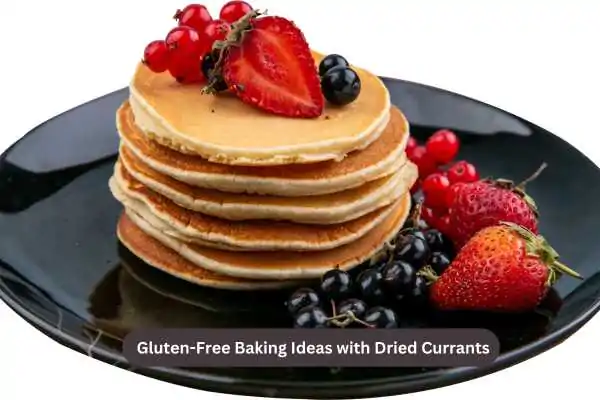Baking without gluten doesn’t have to mean sacrificing flavour, texture, or creativity. In fact, gluten-free baking opens the door to an exciting variety of ingredients, from alternative flours to naturally sweet, nutrient-packed add-ins. One such ingredient that deserves more attention in gluten-free baking is dried currants.

These tiny, tangy-sweet berries pack a surprising punch, both in flavour and in nutritional value. Whether you’re new to gluten-free baking or looking to refresh your recipe collection, incorporating dried currants can transform everyday treats into something truly special.
Why Choose Dried Currants in Gluten-Free Baking?
Dried currants are not just smaller versions of raisins—they have their own distinct taste and texture. They’re naturally tart, slightly chewy, and lend a rich, fruity depth to baked goods. Here’s why they’re a fantastic addition to gluten-free recipes:
-
Nutrient-dense: High in antioxidants, iron, and dietary fibre.
-
Natural sweetness: Reduces the need for added sugar.
-
Versatile: Works equally well in sweet and savoury baking.
-
Size advantage: Their small size means they distribute evenly in doughs and batters.
For gluten-free bakers, dried currants add both interest and balance to recipes that might otherwise rely heavily on starches and alternative flours.
Best Gluten-Free Flours to Pair with Dried Currants
Choosing the right gluten-free flour is essential for achieving a pleasant texture and flavour. Here are some excellent pairings:
-
Almond flour – Rich and nutty, perfect for cakes and biscuits.
-
Oat flour – Offers a wholesome, hearty texture, great in muffins.
-
Rice flour – Light and mild, ideal for delicate pastries.
-
Buckwheat flour – Earthy and robust, great for rustic breads and scones.
-
Gluten-free self-raising flour – Convenient for classic bakes without extra leavening.
5 Gluten-Free Baking Ideas with Dried Currants
1. Gluten-Free Currant Scones
Light, crumbly, and perfect for afternoon tea, currant scones are a British classic. Use a gluten-free self-raising flour blend and fold in a generous handful of dried currants. Serve warm with clotted cream and a spoonful of jam for a truly indulgent treat.
Tip: Chill the dough before baking to help the scones keep their shape and rise beautifully.
2. Oat and Currant Muffins
A wholesome breakfast or snack option, oat and currant muffins are simple to prepare. Combine oat flour with mashed bananas or applesauce for natural moisture, then stir in dried currants for bursts of fruity sweetness.
Serving suggestion: Enjoy warm with a drizzle of honey or a pat of butter.
3. Almond and Currant Tea Loaf
A dense yet tender tea loaf made with almond flour pairs wonderfully with the tartness of dried currants. Lightly spiced with cinnamon and nutmeg, this loaf is perfect for slicing and enjoying with a cup of tea.
Storage tip: Wrap tightly in parchment and store in an airtight tin to keep it moist for several days.
4. Buckwheat Currant Pancakes
For a hearty breakfast, try buckwheat pancakes studded with dried currants. Buckwheat’s earthy notes balance the currants’ sweetness, creating a filling yet flavoursome dish. Serve with Greek yoghurt and a drizzle of maple syrup.
Make-ahead option: Prepare the dry mix in advance and store in a jar for quick weekday breakfasts.
5. Gluten-Free Currant Shortbread
Shortbread is all about simplicity, and dried currants bring a welcome lift to the buttery richness. Use a mix of rice flour and cornflour for a melt-in-the-mouth texture, and press the currants gently into the dough before baking.
Pro tip: Sprinkle with a little caster sugar straight out of the oven for an added crunch.
Baking Tips for Success
Gluten-free baking with dried currants can be straightforward if you follow these key tips:
-
Soak the currants: Briefly soaking them in warm water or fruit juice plumps them up and prevents them from drawing moisture out of the batter.
-
Measure accurately: Gluten-free flours can be more absorbent than wheat flour, so weigh your ingredients for consistent results.
-
Don’t overmix: Overworking gluten-free batters can make them dense. Mix just until combined.
-
Add binders: Ingredients like xanthan gum, psyllium husk, or flaxseed meal help replicate gluten’s structure.
-
Watch baking times: Gluten-free bakes can brown faster—keep an eye on them to avoid overcooking.
Storing Your Gluten-Free Currant Bakes
Because gluten-free goods can dry out faster than traditional bakes, storage is important:
-
Short-term: Store in an airtight container at room temperature for up to 3 days.
-
Long-term: Freeze portions in sealed bags or containers. Defrost at room temperature or warm gently in the oven.
Final Thoughts
Dried currants are a small but mighty ingredient that can elevate your gluten-free baking from good to exceptional. Their tangy sweetness, nutritional value, and versatility make them a pantry essential for anyone baking without gluten.
From rustic scones to delicate shortbread, the combination of gluten-free flours and dried currants creates bakes that are both satisfying and full of character. With the right techniques and a little creativity, you can enjoy the pleasure of homemade treats—without the gluten—any day of the week.

